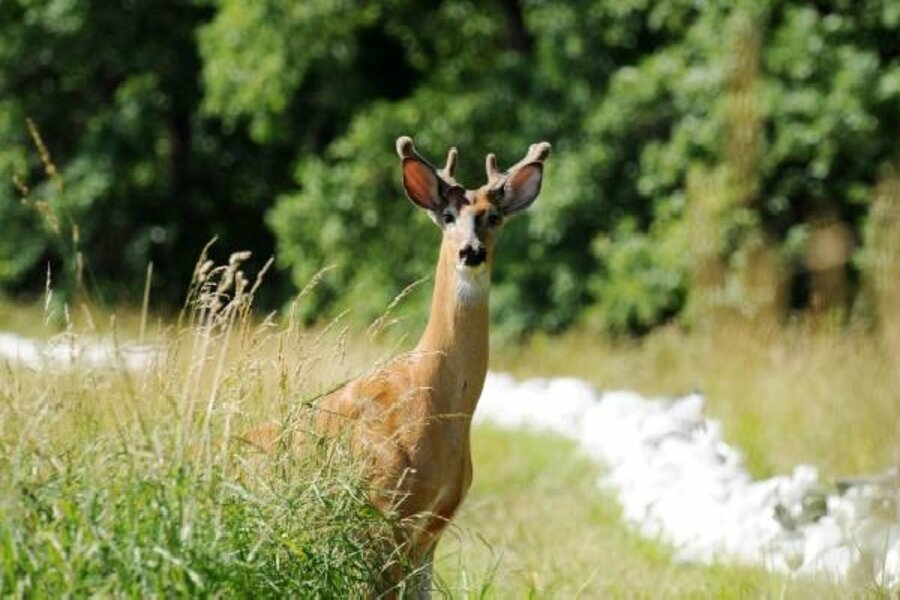Tips to keep deer and other wildlife from munching your plants
Loading...
| WASHINGTON
Homeowners want to enjoy looking at lush plants, but don't want wildlife to enjoy consuming them.
If your plants are getting eaten, the most common culprits are deer. The US population of whitetail deer has ballooned to roughly 29 million from 300,000 in 1930.
Neil Soderstrom offers tips on dealing with the population growth in his book "Deer-Resistant Landscaping: Proven Advice and Strategies for Outwitting Deer and 20 Other Pesky Mammals" (Rodale, 2008).
– Start by keeping deer away from your plants. Fences must be eight feet high to keep deer from jumping them. Many county codes allow six to seven feet. If you must have a lower fence, widen the horizontal distance deer must jump with tall, spreading deer-resistant shrubs along both sides of the fence.
A stiff plastic mesh fence that comes in rolls can be wrapped around and drawn between trees for support in woodland areas without staking. It's black and not very visible. One of the best known is Benner's Deer Fence (800-753-4660, www.bennersgardens.com). Also check see-through mesh netting available under the name Virtually Invisible Mesh Barrier (www.deerfence.com).
– Use plants that deer don't like – those with sticky or hairy leaves; thick, leathery foliage; medicinal uses; or minty or lemony fragrance. Deer prefer fertilized and irrigated plants. The more accustomed they are to people, the better the chance they'll eat ornamentals. If they're hungry, they'll try almost anything.
The evergreens that have the best chance of surviving deer are firs, American hollies, junipers, spruces, cryptomerias, boxwoods, cherry-laurels, mahonias, and viburnums.
To find deer-resistant plants, check out the West Virginia University Extension Service's information on ornamental trees and shrubs (http://www.wvu.edu/~Agexten/hortcult/treeshru/resistan.htm).
– Other ways to deter deer are draping netting over favorite plants, hanging CDs on shrubs to scare them, installing motion-activated automatic sprinklers and using deer repellents.
– Deer are herbivores and stay away from smells that remind them of potential predators. Home remedies include hanging human hair in wool bags on plants or using suet to keep deer away from bird feeders. Commercial products range from putrescent eggs to animal urine. Try an egg-based product like Deer Guard, Coyote Urine, or Hinder, a deer and rabbit repellent made of ammonium salts of fatty acids.
Another class of repellents makes plants taste bad. We had tremendous success in our garden with Messina Wildlife's Deer Stopper, approved for organic growers. Active ingredients are rosemary oil, mint oil, and putrescent whole egg solids.
– Get a pet. Their scents on the plants will deter deer. But be thoughtful of birds you do want in your garden and keep cats contained.
Wildlife shares our space. It's difficult to rid your property of them humanely because it's often illegal to take live-trapped mammals away from properties. Here are some of Mr. Soderstrom's suggestions for repelling other pesky critters:
– Chipmunks. Eastern chipmunks, the only ones in the eastern United States, are considered cute, but their antics make them pests. They are omnivores, eating birdseed, bird eggs, crocuses, and other shallow bulbs. Burrows can undermine porches, stairs, masonry walks and concrete patios. Keep them out of bird food by installing plants with berries birds eat instead of using feeders. Plant serviceberries, hackberries, hollies, viburnums, American bittersweet (Celastrus scandens), American euonymus (E. americanus) and American beautyberry (Callicarpa americana).
– Moles. Tunneling is their greatest threat, creating humps and uneven walking surfaces that can disturb plants' root zones. Moles are insectivores, eating beetle grubs, worms, centipedes, and millipedes. This can be beneficial. Use repellents to discourage them from digging shallow feeding tunnels. Mole Med and Mole & Vole Stopper are safe and can be used by organic growers.
– Rabbits. Rabbits pose a threat to gardeners by eating vegetables, ornamentals, and tree bark in winter. An effective rabbit repellent for organic gardeners is Messina Wildlife's Rabbit Stopper. Quarter-inch wire mesh around tree trunks provides winter bark protection. One-inch wire mesh rabbit fences will protect vegetable and flower gardens.
– Raccoons. They are omnivores and will eat almost any food. You can usually blame them when trash is scattered about or when a hole is ripped into your trash can. They make dens in sheds, chimney flues, and houses. Eliminate food sources, cover all openings to houses or sheds, use trash cans that latch, cover compost containers, cover gardens with wire mesh, and install pet doors that latch. Raccoons don't just harbor ticks and fleas; they're also susceptible to rabies, worms, and other parasites and can pass them on to humans.
– Voles. Primarily herbivores, they eat roots of ornamental plants, stems, seeds and tree bark. This makes them a greater pest to gardeners than moles. Their burrows are shallow, and they feed around the clock. Mole & Vole Stopper is a safe, effective repellent.
Joel Lerner is president of Environmental Design in Capitol View Park, Md., and author of "Anyone Can Landscape." Contact him through his website, www.gardenlerner.com.
Editor's note: For more garden articles – at least one new one each weekday – click here. And don't forget to bookmark and drop by our lively garden blogs. Consider us a daily mini gardening magazine.





